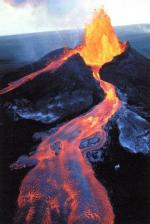|
This section contains 867 words (approx. 3 pages at 300 words per page) |

|
Volcanoes are vents or fissures in Earth's crust through which lava, gases, and pyroclastic debris are released. More commonly, the term volcano refers to the landform built up from the accumulation of lava and/or pyroclastic debris. Based on the timing of their last eruption, volcanoes are classified as active (having erupted during historic time), dormant (having no recent eruptions, but with the potential to erupt again), or extinct (having no historic eruptions and showing no evidence of future eruptions). There are currently over 500 active volcanoes on Earth's surface, including famous examples such as Mt. Fuji, Mt. St. Helens, and Mauna Loa. Mt. Vesuvius, which last erupted in A.D.79, is an example of a dormant volcano; Mt. Kilimanjaro is an extinct volcano.
Fueled by Earth's internal processes, volcanoes occur primarily along plate boundaries but also form above hot spots. Eruptive activity may include lava flows, lateral blasts...
|
This section contains 867 words (approx. 3 pages at 300 words per page) |

|


